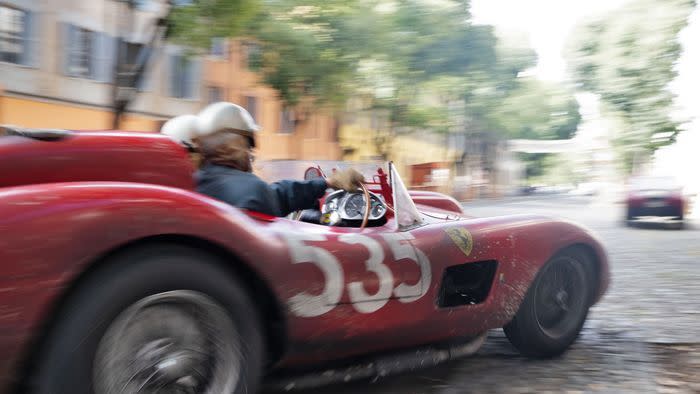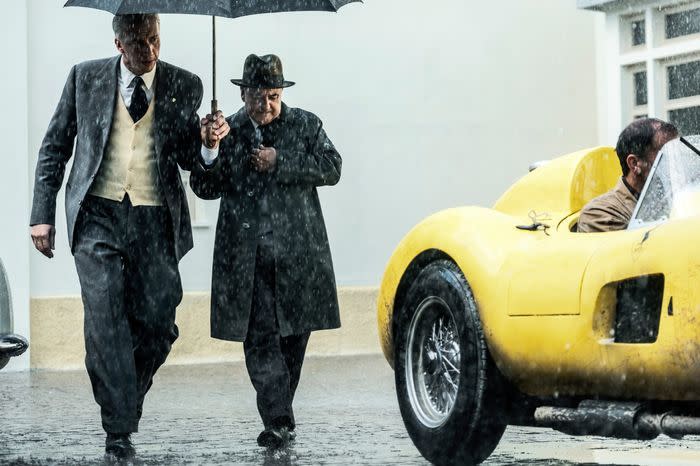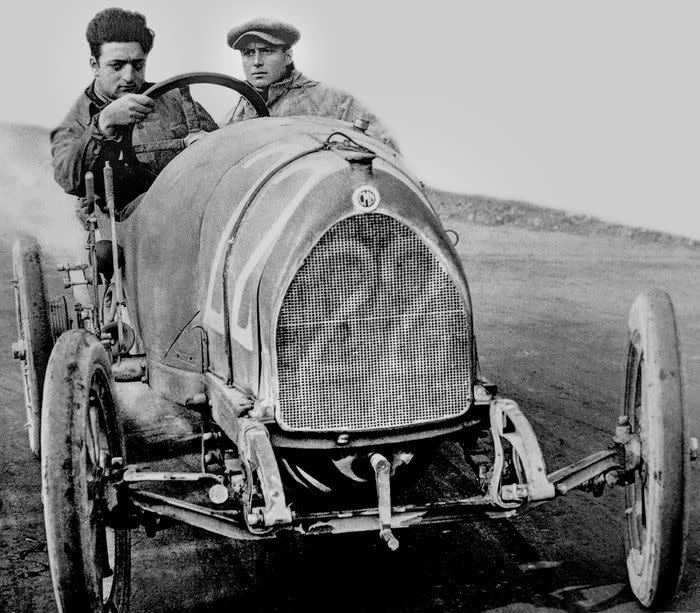‘Ferrari’ the Movie Is as Real as Hollywood Can Be

Ferrari the movie is out Christmas Day. It's good. Go See it.
Director Michael Mann packs as much realism into the story as any Hollywood racing movie is ever going to get. That might not be enough for you, but don't let your knowledge interfere with what is a lively telling of an epic story.
You'll see Patrick Dempsey and Derek Hill, too!
If conflict is the essence of drama, Enzo Ferrari led a dramatic life.
Director Michael Mann and screenwriter Troy Kennedy Martin—both working with the late, great Brock Yates’ book—finally got that life hammered and wedged into a two-hour movie.
Did they do it right? Yes, for the most part, and you should go see it. If only for the cars, which are all accurately portrayed and professionally driven by the likes of racer/actor Patrick Dempsey, who plays Piero Taruffi, and by Derek Hill, son of Phil, who plays Jean Behra.

There are bits and pieces of Enzo’s real life throughout, rearranged like chess pieces in a new order to make that drama, but ultimately they make it well.
The main dramatic conflict has to do with Enzo’s women. He had trouble with them. This much we can gather already. But he also had troubles with: Maserati, with his critics, with the Catholic church, the press, mid-engine powertrains, disc brakes, his mistress(es), and with people yelling race strategy suggestions as he walks down the street on the way to work.
But in spite of all that, or maybe because of it, Ferrari the man made fantastic cars and used them to win the world’s greatest races. In so doing he constructed a heralded brand that would last long after his death in 1988 at age 90 and grow into the multi-billion-dollar empire that it is today, where—still—only a small handful of the world’s richest people can own one of his cars but everyone else can own a licensed and trademarked Ferrari hat.
Picking which parts of this large and legendary life to put on screen could not have been easy. Rather than try and get it all into two short hours, director and producer Mann decided to focus on just a couple of days. Specifically, the days before and after the 1957 Mille Miglia.
Kennedy and Mann took a few pages from the middle of Yates’ Ferrari biography that covered that race and from that, much of this cinema flows.
The movie takes the real Mille Miglia and reconstructs it somewhat accurately, depending on how much you know about that 1000-mile flat-out thrash around Italy, from Brescia to Rome and back again through public streets with no speed limits, no barricades and no crowd control.
It places that nearly chaotic race into a swirl of Ferrari intrigue that is also somewhat compressed and sometimes presented in a completely different order than it happened in real life but still manages to make sense as a story.
The pretense the movie presents is that Ferrari is going to go bankrupt unless he can win the Mille and sell more cars. Win on Sunday sell on Monday. That’s not really accurate because, by all historical accounts, Ferrari the company was doing fairly well in 1957, having just won the world championship with Juan Manuel Fangio the year before and selling about as many street cars as it could produce.
But then Ferrari’s wife, Laura, played with focused, repressed, and long-simmering rage by a splendid Penelope Cruz—right down to the chopped bob of a hair style she wears that vibrates with all the intensity of her anger—finds out about Ferrari’s long-time mistress, Lina Lardi.
Laura has financial control over the Ferrari empire and can ruin everything by cashing a single check she has judiciously extracted from her husband right at the same time she learns of his infidelity. Whether and how this may or may not have happened in real life is difficult to ascertain, but it works as a plot device.
Then Mann and Martin throw in unnecessary subplots like Ferrari’s manipulations of Ford and Fiat, which historically wouldn’t happen for another six years, for no apparent reason except to heighten the drama.
Add to that the recent and painful death of Ferrari’s “legitimate” son Dino, and the existence of his “illegitimate” son Piero, and the agonies those present, and you have the whole movie, all these different plates spinning in the air like so many hubcaps after an accident.

And there is an accident, presented in all the gruesome detail of the time, perhaps unnecessarily, depending on your level of squeamishness. I first saw it at the Director’s Guild in Hollywood and even the hard-bitten professionals and cinephiles sitting around me gasped when this particular scene popped up.
Does the 6-foot-2 Adam Driver play a convincing Enzo Ferrari? He does wear the pants hiked up to above-belly button altitude and held in place by Enzo’s trademark suspenders, and the real Enzo (did you know this?) was 6-feet-2 just like Driver.
But you can’t help but think they could have gone down to any piazza in Modena or Maranello and plucked any overweight, receding-hairline, bocce ball player and gotten a more convincing-looking Enzo. Driver is too skinny.
Driver plays him as a cold, calculating, humorless race team owner bent on winning at all costs—the character we all assumed Enzo Ferrari was. Race car drivers, to Enzo, were as disposable as tires. But in reality, at least among men, and at least in his younger years, Enzo could be quite gregarious. It was how he built the empire, going from Costruzioni Meccaniche Nazionali to Alfa Romeo and finally to his own race team and manufactury.
Penelope Cruz as Laura Ferrari will surely get an Oscar for Best Supporting Actress for the seething rage she keeps in most, but not all, of the time. She can carry two bags of groceries with more anger than most humans could contain. At one point she fires a gun at Enzo, so fed up is she with his philandering. Then later, in negotiations to allow him power of attorney for her part of the company, she asks that she get her gun back.
Shailene Woodley as the other woman Lina Lardi provides the safe sanctuary Enzo needs, but why is she so accepting of her lot in life? She has a villa on the outskirts of Modena where she raises her and Enzo’s son, Piero (who now owns 10% of Ferrari, btw, making him one of the richest men in the world).
The driving scenes are among the best you’re ever going to get out of Hollywood, with an imperceptible mix of real cars and recreations. You won’t be able to tell which is which. The presentation of the Mille is well-done, if not entirely accurate.
Again, it depends on how much you know about this subject. If you know just a little bit, you’ll think they did a great job. If you know too much, you may shake your fist at the screen the way Grampa Simpson does when he yells at the cloud.
But whichever viewer you are, you’ll leave the theater happy. Mann treats his subject with as much reverent accuracy as Hollywood will ever muster. You won’t get this attention to detail, flawed as it sometimes is, from any other production. We’ll get into more details about the cars, the stunts, and exactly which parts were accurate and which weren’t in subsequent stories.
But for now, yes, go see the film when it opens Christmas Day. You won’t be disappointed.

 Yahoo Autos
Yahoo Autos 